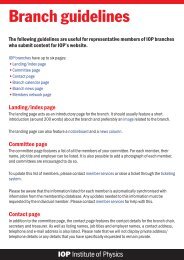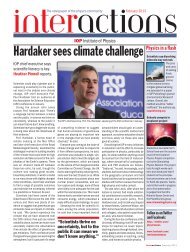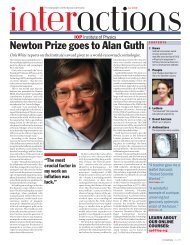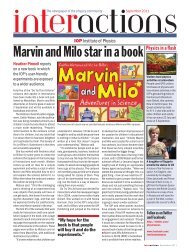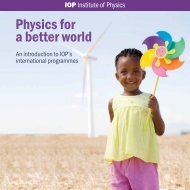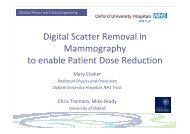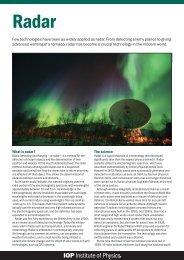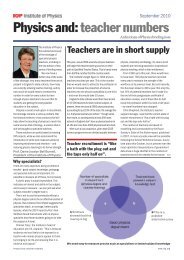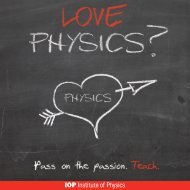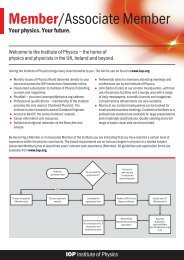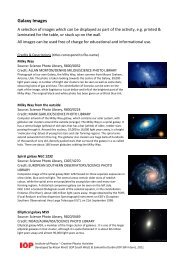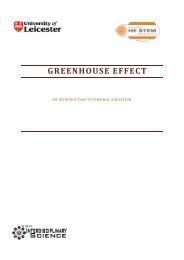Girls in the Physics Classroom: A Teachers' Guide - Institute of Physics
Girls in the Physics Classroom: A Teachers' Guide - Institute of Physics
Girls in the Physics Classroom: A Teachers' Guide - Institute of Physics
You also want an ePaper? Increase the reach of your titles
YUMPU automatically turns print PDFs into web optimized ePapers that Google loves.
4: Appendices<br />
Table 4.8: Be passionate about physics<br />
Make a note for yourself<br />
What is <strong>the</strong> essence <strong>of</strong> <strong>the</strong> subject, for<br />
you personally? How have you tried to<br />
present this to your students?<br />
When will your students have seen you<br />
enjoy<strong>in</strong>g your teach<strong>in</strong>g? How could you<br />
do more <strong>of</strong> this?<br />
Discuss with o<strong>the</strong>rs<br />
What makes you enthusiastic about<br />
physics? How are its satisfactions<br />
different from o<strong>the</strong>r subjects?<br />
not someth<strong>in</strong>g to burden <strong>the</strong> students with, however.<br />
Please note that no assumptions are be<strong>in</strong>g made here<br />
about what qualifications are necessary to teach physics.<br />
Enthusiasts <strong>in</strong> <strong>the</strong> subject have all k<strong>in</strong>ds <strong>of</strong> backgrounds.<br />
When you are teach<strong>in</strong>g physics, whatever your o<strong>the</strong>r experiences<br />
and expertise, you need to care about physics.<br />
Resources for fur<strong>the</strong>r activities and advice<br />
Support<strong>in</strong>g <strong>Physics</strong> Teach<strong>in</strong>g (11–14) <strong>Institute</strong> <strong>of</strong> <strong>Physics</strong><br />
(2006)<br />
This set <strong>of</strong> five CD-ROMS is a m<strong>in</strong>e <strong>of</strong> useful material for<br />
teachers. Designed for non-physics teachers it never<strong>the</strong>less<br />
has useful ideas relevant to <strong>the</strong> <strong>the</strong>mes <strong>of</strong> <strong>the</strong>se programmes.<br />
For example, <strong>the</strong> Forces CD-ROM <strong>in</strong>cludes a film<br />
<strong>in</strong> which pupils discuss <strong>the</strong>ir ideas about forces on objects.<br />
The Electricity resource explores analogies for electrical<br />
quantities, such as ropes, hills and delivery vans.<br />
Pedagogy Pack Science National Strategy (2005)<br />
This is a set <strong>of</strong> 20 units on a range <strong>of</strong> teach<strong>in</strong>g, learn<strong>in</strong>g and<br />
What opportunities have you taken to<br />
spend more time teach<strong>in</strong>g what really<br />
turns you on <strong>in</strong> physics? How could you<br />
do more? Does it need to be<br />
extracurricular or can you suspend <strong>the</strong><br />
syllabus for a while?<br />
I NSTITUTE OF P HYSICS R EPORT G IRLS IN THE P HYSICS C LASSROOM: A T EACHERS’ GUIDE FOR A CTION D ECEMBER 2006<br />
Try out <strong>in</strong> class<br />
In appendix 4.2 <strong>the</strong>re is a<br />
questionnaire <strong>in</strong> which questions 7–9<br />
explore what students th<strong>in</strong>k about<br />
physics. Use this as <strong>the</strong> basis for a<br />
discussion with <strong>the</strong>m.<br />
Take some time to expla<strong>in</strong> to <strong>the</strong> class<br />
<strong>the</strong> relationship <strong>of</strong> a particular topic <strong>in</strong><br />
physics to <strong>the</strong> subject as a whole.<br />
class-management strategies for teachers’ self-study. There<br />
are units on question<strong>in</strong>g, group work, active engagement<br />
and modell<strong>in</strong>g, each <strong>of</strong> which conta<strong>in</strong>s suggestions that<br />
may help <strong>in</strong> <strong>the</strong> teach<strong>in</strong>g <strong>of</strong> girls <strong>in</strong> physics.<br />
Only Connect Science Year CD ASE (2001)<br />
This compendium <strong>of</strong> resources <strong>in</strong>cludes a useful section<br />
about how to get pupils talk<strong>in</strong>g about science concepts<br />
through analogies.<br />
Look<strong>in</strong>g and Learn<strong>in</strong>g <strong>in</strong> Science and Improv<strong>in</strong>g Teach<strong>in</strong>g<br />
and Learn<strong>in</strong>g <strong>in</strong> Science<br />
Success for All, DfES (2004/5)<br />
These two CPD packs each <strong>in</strong>clude DVDs/CD-ROMs. The<br />
target audience is teachers <strong>of</strong> 16–19-year-old students but<br />
<strong>the</strong>re are relevant sections on tak<strong>in</strong>g students ideas seriously,<br />
gett<strong>in</strong>g to know students better and mak<strong>in</strong>g content<br />
relevant. The resources span all <strong>of</strong> <strong>the</strong> sciences but <strong>the</strong>re is<br />
a physics-specific disc <strong>in</strong> <strong>the</strong> latter.<br />
33



